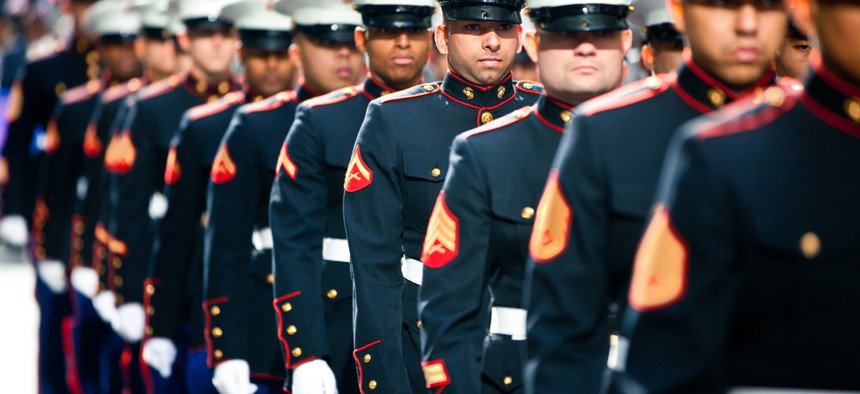
Marines Marching during the 2011 New York City Veterans Day Parade Flickr user DVIDSHUB (Creative Commons)
VA Reform Debate Misses Larger Veterans Issue
The recent debate over VA reform only scratches the surface of a much larger veterans issue - the civil-military divide.
The Department of Veterans Affairs scandals and the subsequent reform bill passed by Congress have placed veterans issues in the political spotlight for the moment. But the debate over reform at the VA only scratches the surface of a much larger veterans issue - the civil-military divide. A recent nationwide poll of Iraq and Afghanistan veterans by The Washington Post and the Kaiser Family Foundation found that 55 percent often or sometimes feel disconnected from civilian life as a result of their military service.
Furthermore, 69 percent said they often or sometimes feel average Americans cannot identify with their experience.
Part of the problem is, as 51 percent of the poll’s respondents indicated, the military is not doing enough to help veterans transition back to civilian life. However, the underlying cause may be the growing disconnect between civilian and military communities since the decision to end conscription and permanently establish the All-Volunteer Force in 1973. During the Vietnam War, the last war involving the draft, nearly 10 percent of Americans served in the military on active-duty. Today, less than 1 percent do so.
The professionalization of U.S. armed forces has further contributed to a form of isolation of military personnel. Troops and their families live on large bases separate in many ways from civilian society, and children of military personnel are much more likely to sign up to serve than other children. This is not to suggest that bringing back the draft is the solution. As Chairman of the Joint Chiefs of Staff General Martin Dempsey wrote last summer to commemorate the AVF’s 40th anniversary, “it’s been so effective that we often take it for granted.” Instead, the focus should be on how both civilians and veterans can better engage one another to ensure a healthier and more robust civil-military relationship.
At a recent event hosted by Defense One and Iraq and Afghanistan Veterans of America, veterans advocates identified the “otherization” of veterans in society as a significant impediment to their reintegration into civilian life. During the session, “The 1 Percent: Bridging the Military-Civilian Divide,” a panel of veterans including Representative Tulsi Gabbard, host of MSNBC’s “Taking the Hill” former Representative Patrick Murphy, former VA digital engagement officer Alex Horton, and Team Rubicon Division Administrator Mike Monroe argued that elevating veterans’ stories in the public discourse is key to bridging the disconnect.
Most Americans hear about veterans issues through the media, which, more often than not, highlights negative stories. As a result, they may be led to believe veterans are “others" with whom they cannot identify. By contrast, promoting positive stories and open conversation would help average Americans better identify with veterans, and help veterans become more comfortable talking about their own experiences. The veterans on the panel agreed that the onus is on them to get this conversation going, but, for the average American, the imperative is to challenge stereotypes and engage our veterans.
This post is written by Government Business Council; it is not written by and does not necessarily reflect the views of Government Executive Media Group's editorial staff. For more information, see our advertising guidelines.



